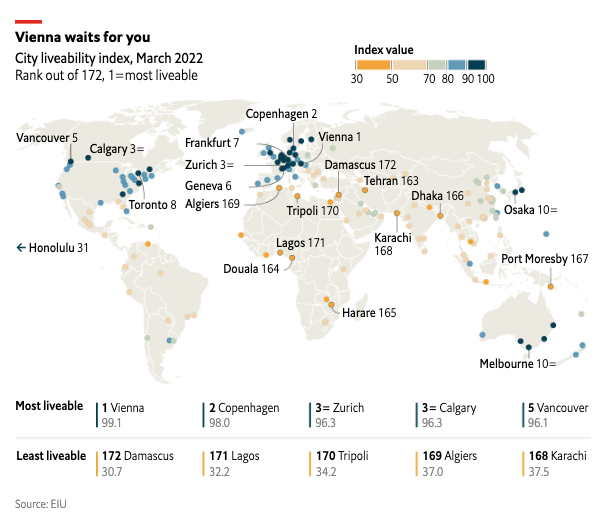

In Vienna they call it Lebenskunst—the art of living well—and now that restaurants and museums in the Austrian capital have reopened, it is once again the perfect place to practise the art. A new survey of “liveability” by EIU, our sister company, agrees. For the third time in the past five years, Vienna has come top of the EIU’s ranking. The city offers plenty of opportunities for culture and entertainment, as well as good infrastructure and overall stability. Five other small European cities feature in the top ten, having also benefited from the easing of covid-19 restrictions. Yet since last year Paris and London, which usually perform less well in the ranking because of big-city problems like congestion and crime, have soared 23 and 27 places to 19th and 33rd respectively, as they start to treat covid as endemic rather than a pandemic. (See chart.)
Originally designed as a tool to help companies assign hardship allowances as part of expatriates’ relocation packages, the EIU’s index rates living conditions in 172 cities (up from 140 last year) based on more than 30 factors. These are grouped into five categories: stability, health care, culture and environment, education and infrastructure. This is the second year in which the index incorporates indicators related to covid; these assess how each city has coped with increased demand on health–care facilities and with closures or capacity limits for schools, restaurants and cultural venues.

A partial return to normality is not confined to western Europe. Three Canadian cities have moved into the top ten, while New York, Los Angeles and Washington, DC have all improved compared with last year. According to The Economist’s normalcy index, which tracks travel, recreation and office use, activity in America and Canada is now at around nine-tenths of pre-pandemic levels. Global activity is only around one-sixth lower than before the virus emerged. This is reflected in the global average liveability score, which has bounced back to something approaching normality.
For some cities to rise, others must fall. Every city in China has slipped down the rankings, and cities in island nations with strong border controls that scored well a year ago are suffering now. Auckland came top last year, with few covid cases and even fewer restrictions. But in March, when the survey was conducted, the highly contagious Omicron strain caused a spike in cases in New Zealand—and the city dropped 33 places.
The war in Ukraine is also weighing on liveability. There is no score in 2022 for Kyiv because the EIU’s correspondent had to abandon the survey when fighting broke out. Moscow and St Petersburg have dropped 15 and 13 places to 80th and 88th, as hundreds of Western firms have pulled out of Russia and censorship has increased. Other cities affected by the contagion of war, such as Budapest and Warsaw, saw their stability scores slip as geopolitical tensions increased.
If the war continues throughout this year, more cities could suffer disruption to food and fuel supplies. The welcome rise in liveability this year might be short-lived. ■
Comments are closed.
